Sardinia is out of time and history. This land resembles no other place.
A brief description of Gallura
.jpg)
Gallura is a historical denomination of the north-eastern geographic area of Sardinia, comprised to the west by the Coghinas river, to the south by Mount Limbara, and the south-east by Mount Nieddu, as far as the municipality of Budoni. Here, the eastern boundary is represented by the river of the same name that flows through the locality as mentioned above. The territory, made up of more than 20 municipalities such as Tempio Pausania, Olbia, La Maddalena, Arzachena, Calangianus, Luras, Aggius, Bortigiadas, Santa Teresa Gallura, Luogosanto, Palau, Aglientu, Trinità d'Agultu e Vignola, Telti, Golfo Aranci, Badesi, Viddalba, Sant'Antonio di Gallura, Loiri Porto San Paolo, San Teodoro, Budoni, Erula and Padru. According to some hypotheses, the name Gallura - Gaddura in Gallurese language - means "rocky", "stony", a fact that would seem to be confirmed by the essentially rocky and mountainous nature of this part of the territory. There is an abundance of granite rock polished by the erosive action of the wind, rain, and sea, particularly on the coasts, where we can admire natural sculptures with original and bizarre shapes, as in the case of the Bear Rock near Palau. The coast is mainly indented, with long, narrow inlets - such as the Gulf of Arzachena and the Gulf of Olbia - and dotted with numerous islands, the main ones being La Maddalena and Caprera. In terms of relief, the territory is characterised by an array of short granite ridges, rugged by very pronounced hydrography - the Liscia river - and The highest peak of the Limbara massif is La Punta Balistreri, the highest in the whole of northern Sardinia. Gallura has spontaneous vegetation, where the typical Mediterranean scrub covers the coastal portion with mostly lentisk, cistus, arbutus, and myrtle. In contrast, the inland, sheltered from the winds and characterised by granite outcrops, has forests of oak and cork trees, the processing of which represents a flourishing productive activity in the region.
Sea and beaches
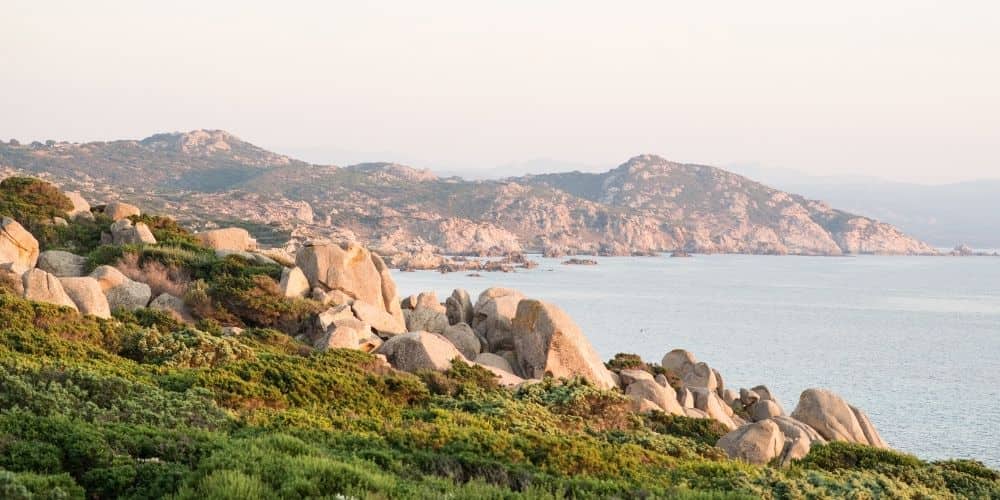
Renowned for its paradisiacal sea, small dreamy coves, suggestive views, and exclusive locations, Gallura is the real jewel in the crown of the region's tourist offer. It is considered the bridge to Corsica's island opposite, about 10 nautical miles from Santa Teresa di Gallura to Bonifacio. Its coasts overlook a sea with crystal-clear waters ranging from emerald green to light blue. Famous are the walks in the elegant boutiques, the social life, and the nightlife in the famous Piazzetta (lit. square) of Porto Cervo, one of the wealthiest and most exclusive places on the coast. This is the Costa Smeralda: an exclusive place with its Longosardo tower overlooking the tourist port of Santa Teresa di Gallura and the Maddalena Archipelago, a natural heritage of inestimable value together with Spargi, Cala Corsara, Budelli, and its wonderful pink beach. And then, there is Capo Testa, in the bay of La Colba and the fantastic beach of Santa Reparata and the beaches of Rena Bianca and Rena Majore where you will feel an invitation, a call to dip your hands in this fine white sand that looks like flour. In Palau, facing the Maddalena Archipelago, you will see an unusual guardian with a majestic appearance, the famous rust-coloured Bear Rock (Roccia dell'orso) that dominates the surrounding area. A sculpture created by Mother Nature thanks to erosive phenomena, which is not the only example in Gallura. In fact, in Vaccileddi, in the municipality of Loiri Porto San Paolo, located on the beach of Cala Ghjlgolu, we can admire the equally spectacular Turtle Rock that juts out directly from the transparent waters.
In front of Capo d'Orso, you can stop on the island of Caprera (part of the Maddalena Archipelago): it's famous for the Hero of Two Worlds, Giuseppe Garibaldi, who lived his last years here and where he died and where you can visit his last home or House Museum, a truly unique and exciting experience. Then, there is the island of Tavolara, an itinerary immersed in legends, history, and a sky that seems to dive into the sea, directly at one with its marvellous waters. Finally, San Teodoro, an area that forms an integral part of the Tavolara - Capo Coda Cavallo Marine Park, with its authentic natural spectacles offered by Cala d'Ambra, La Cinta, and Isuledda, literally framed between the pond and the sea.
Gallura is that hilly-mountainous area in the northeast of Sardinia, which shows itself in all its peculiar characteristics, different from the rest of the island, thanks to its characteristic granite landscapes and vivid colour contrasts. Truly magical, relaxing, and soothing places where you can close your eyes, smell the perfume and listen to the sound of the sea to get in deep contact with land to be known with all five senses.
Gallura: traditions, folklore and culture
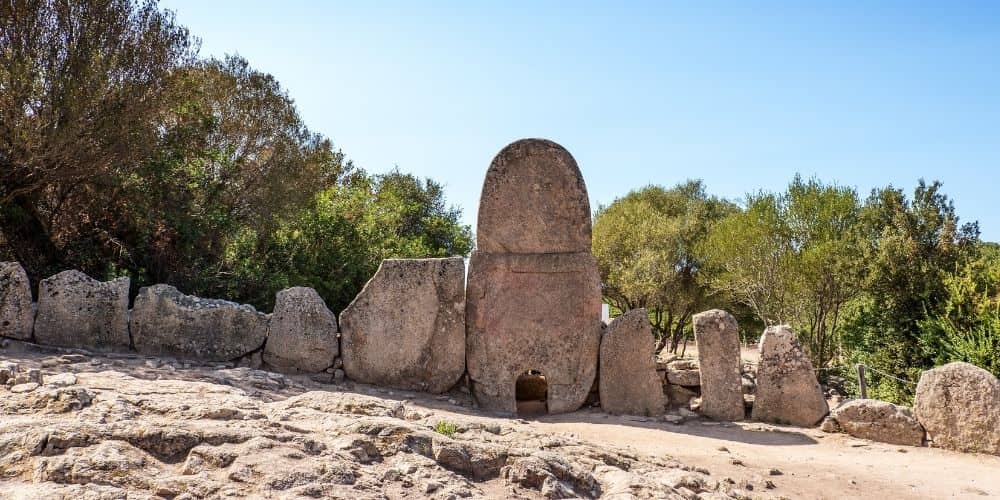
Undoubtedly, the sea is best and most familiar about Gallura, but that is not all. This area is overshadowed by the crystal-clear waters and almost evanescent beaches of fine, soft sand. It boasts a thousand-year-old archaeological history, to be discovered just a few kilometres from the coast. These are real treasures of inestimable value, jealously and proudly guarded by the local population. Symbols of an ancient civilisation, the nuraghe, are certainly worth a visit, such as the Nuraghe la Prisgiona, in the municipality of Arzachena, a complex consisting of a nuraghe surrounded by a village of huts covering an area of 5 hectares. Although a large part of the village has been buried under the ground, the huge extension demonstrates the community's high level of organisation. In addition, in the municipality of Arzachena, we find the famous Tombe dei Giganti, a Nuragic-type tomb dating back to 1400 B.C. approximately. This site represented where the local community paid their homage to the dead people of the community and consisted of a burial chamber 30 metres long and 3 metres wide. In addition to la Prisgiona, the Nuraghe Majori of Tempio Pausania is worth mentioning. It dated back to the Middle Bronze Age (1400 BC) and was built with huge stones and impressive features. It is one of the most significant and representative monuments of the whole Gallura region. During the excavations, ceramic objects were brought to light, mostly utensils for daily use, which testify to its function as a dwelling and, clearly, as a means of controlling the territory itself. A small curiosity linked to this place: inside, a colony of Rinolophus Hipposideros, tiny bats, migrates in April and stays there until October.
For nature lovers, the Millenary Olives of Luras, thousands of years old specimens of olive trees on the hills around Lake Liscia, are a must-see. They are considered true natural monuments, both for their longevity and for their large size. The largest of them, called the Great Patriarch, is the oldest olive tree in Europe. 14 metres high and 12 metres in circumference, it covers an area of 600 square metres. These characteristics led to its recognition as a "Natural Monument" in 1991 and its inclusion in the list of Italy's 20 secular trees.
Liscia Lake, an artificial lake mentioned earlier, is situated between Luras, Sant'Antonio di Gallura and Lugosanto and is set in a truly unique and enchanting natural context. An excursion by boat is highly recommended.
Tied to the traditions of Gallura families is the mysterious character of the Femina Agabbadora of Luras, to whom a museum is dedicated. It seems that she was a woman who, by means of a hammer made of olive wood, put an end to the suffering of seriously ill people. The Sardinian term "agabbadòra" means "she who puts an end". A visit to the museum is a journey into the past in a typical Gallura house to discover local customs.
Another experience not to be missed, during the summer season, is a suggestive excursion to Mount Limbara along its trekking routes among granite towers and rocks of the most varied and singular shapes. An ideal place for birdwatchers and nature photography lovers.
Also, for those passionate about Sardinian history and culture, the Museum of Banditry in Aggius is the perfect opportunity to get to the heart of the famous brigands' era through numerous important findings. Firearms, mug shots of the wanted men, reproductions of an old police station and authentic documents dating back to Spanish domination. A museum sui generis, unique in Italy, fascinates you with its flavour of the "Italian Far West".
Another place not to be missed is the village of Aggius - awarded the Touring Club's orange flag - whose historic centre takes us back to the 19th century in Gallura, with cobbled streets, granite houses and beautiful museums. This town, however, has experienced a period of feuds and infighting. Legend has it that the devil lived hidden in the mountains behind this village. It was from these mountains that the sound of drums heralded terrible nights of bloodshed. Moreover, the Valle della Luna (Moon Valley) of Aggius, offers one of the most suggestive views of the whole Gallura. In these places, the rocky Gallura offers the best of itself. Taking advantage of a short break, we suggest you taste the cold cuts, accompanied by excellent local wines.
And finally, to fully experience the folklore of Gallura, in spring, the customary appointment with La Primavera in Gallura (lit. Spring in Gallura). This is an itinerant event involving several municipalities in Gallura and aims to retrace the old transhumance paths with ox-drawn carts. Through these "countryside paths" or "paths of memory", you will experience an itinerary to discover professions that have now disappeared. You will savour the atmosphere of this particular traditional event steeped in culture, immersed in vivid colours, heady scents and enchanted by authentic and genuine flavours.
Food and wine in Gallura: unique aromas and flavours
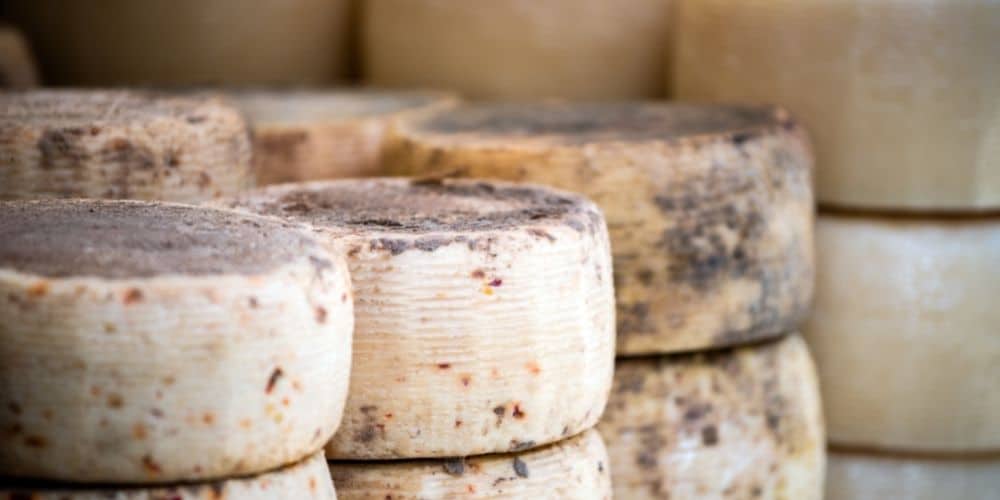
If Sardinia leads the way in terms of food and wine traditions and incomparable flavours, the Gallura region is no less so. The area has always had a millenary vocation linked to sheep farming and agriculture in the green pastures. These family-run farms are known as "stazzi", a term derived from Latin to indicate a "place where you stop". Here, families of farmers and shepherds live off the fruits of their labours in the fields and livestock farming. Typical dishes, traditional products and wines that you absolutely must try, in a real itinerary of flavours, fragrances, history, and tradition make Sardinia an authentically genuine land. Let's start with Zuppa Gallurese (or Gallurese soup) prepared with stale bread, seasoned pecorino cheese, spices, chopped parsley, meat broth, and baked in the oven and once cooked on feast days or for wedding dinners. Gnocchi galluresi are handmade gnocchi made with durum wheat flour and water and the back of a grater or chopping board to give them a wrinkled surface. Excellent with a simple tomato and basil sauce or with beef, sausage or wild boar sauces. Then there are the Ravioli di ricotta (ravioli stuff with ricotta cheese), which differ from ravioli from other parts of Sardinia. Here, a hint of sugar and lemon is added to give a pleasant, refreshingly sour aftertaste.
Moreover, we can taste the lesser-known Mazza frissa or "fried semolina": a mixture similar to béchamel sauce made with fresh milk cream and durum wheat semolina. It is traditionally served with honey and savoury dishes such as stewed broad beans and as a sauce for gnocchetti with a sprinkling of black pepper. And how can we not talk about the prince of Sardinian meat? The porcetto or "porceddu" is the classic suckling pig, tender and delicious, with a crispy, biscuit-like rind. Also very popular are lamb and kid, the latter prepared in a stew accompanied by a broth of onions, celery, carrots and potatoes or roasted on a spit and cooked slowly, sprinkled with melted lard.
There is also a wine that crowns these exquisite and succulent dishes: Vermentino di Gallura, the island's most famous white wine and also the only one with a DOCG designation in Sardinia. This wine is characterised by its Mediterranean notes, the scents of the region and its sea.
We also recommend Nebiolo di Luras, a red wine ideal for accompanying meat dishes such as Zuppa Gallurese, roast meat, cheese or salami. No meal does not end with Fileferru - a distillate made from the finest pomace - or with the delicious and fragrant myrtle liqueur, or with the wide variety of pastries in the Sardinian tradition. It would be best to try the typical cheeses, such as Pecorino Cheese Gallurese DOP and the many types of fresh or mature cheeses of the local gastronomic tradition. Of course, near the coast it is a must to enjoy typical dishes based on freshly caught fish. Sea or inland, let yourself be conquered by the flavours of Gallura's food and wine culture: from sweet to savoury, from fish to meat, from starters to desserts!
The prestigious Delphina Group's Hotels in Northern Sardinia
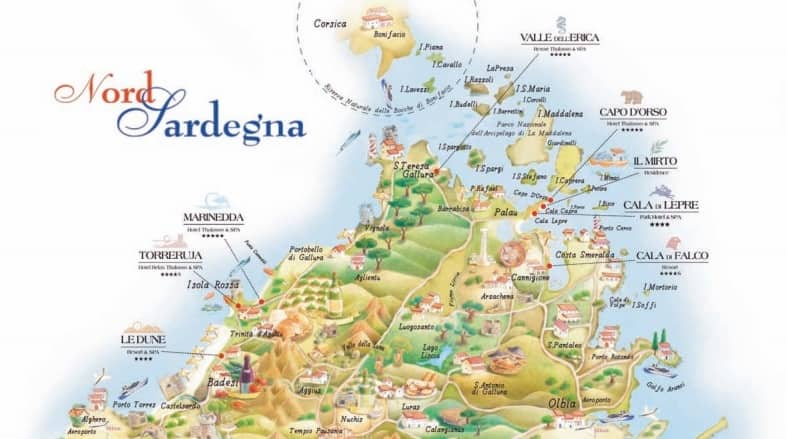
Set in the paradisiacal setting offered by northern Sardinia, the Delphina Group's Hotels are a real cherry on the cake, completing the tourist offer by providing 5-star hospitality worthy of Sardinian excellence. What makes the group's hotels unique is the perfect mix of culture, tradition, efficiency, and passion for their land, all aimed at satisfying the most particular desires of the most demanding client with the utmost professionalism. You will have the opportunity to taste Sardinian specialities, prepared from fresh and genuine food and 0 km in respect of an unparalleled gastronomic tradition. The pleasure of the palate will match the joy of the view, overlooking a sea that has been awarded several blue flags in 2021. The Delfina Group's hotels offer numerous experiences and opportunities. You can combine thalassotherapy or multiple water sports - snorkeling, SUP, kayaking, sailing with catamarans, kitesurfing, and windsurfing-, or activities such as beach volleyball, horse riding, golf, tennis, archery: you can stay outdoors and keep fit!
Nothing is left to chance at the Delphina Hotels that take care of all the details to give guests an unforgettable holiday in a region just as unique... All you have to do is choose the Hotel you prefer and book your stay from the following proposals:
Hotel Capo d'Orso, a romantic 5-star hotel in Palau, where you can admire the rock sculpture bearing the same name.
Resort Valle dell'Erica, Hotel Erica and Hotel La Licciola, both 5-star dream hotels in Santa Teresa di Gallura.
Hotel Marinedda, an elegant 5-star hotel near the village of Isola Rossa, with a spectacular view over the Gulf of Asinara.
Resort Cala di Falco, a super 4-star hotel at the gateway to the Costa Smeralda, a stone's throw from the village of Cannigione.
Hotel Torreruja, a romantic 4-star super hotel in Isola Rossa.
Park Hotel Cala di Lepre, a 4-star structure 3 km from the center of Palau, ideal for families with children.
Le Dune Resort, made up of four 4-star hotels and a 4-star superior, overlooking the sea at Badesi.
Residence Il Mirto, refined and exclusive flats in Palau, overlooking the Maddalena Archipelago.
DISCOVER MORE ABOUT DELPHINA HOTELSEcotourism: Delphina for the environment
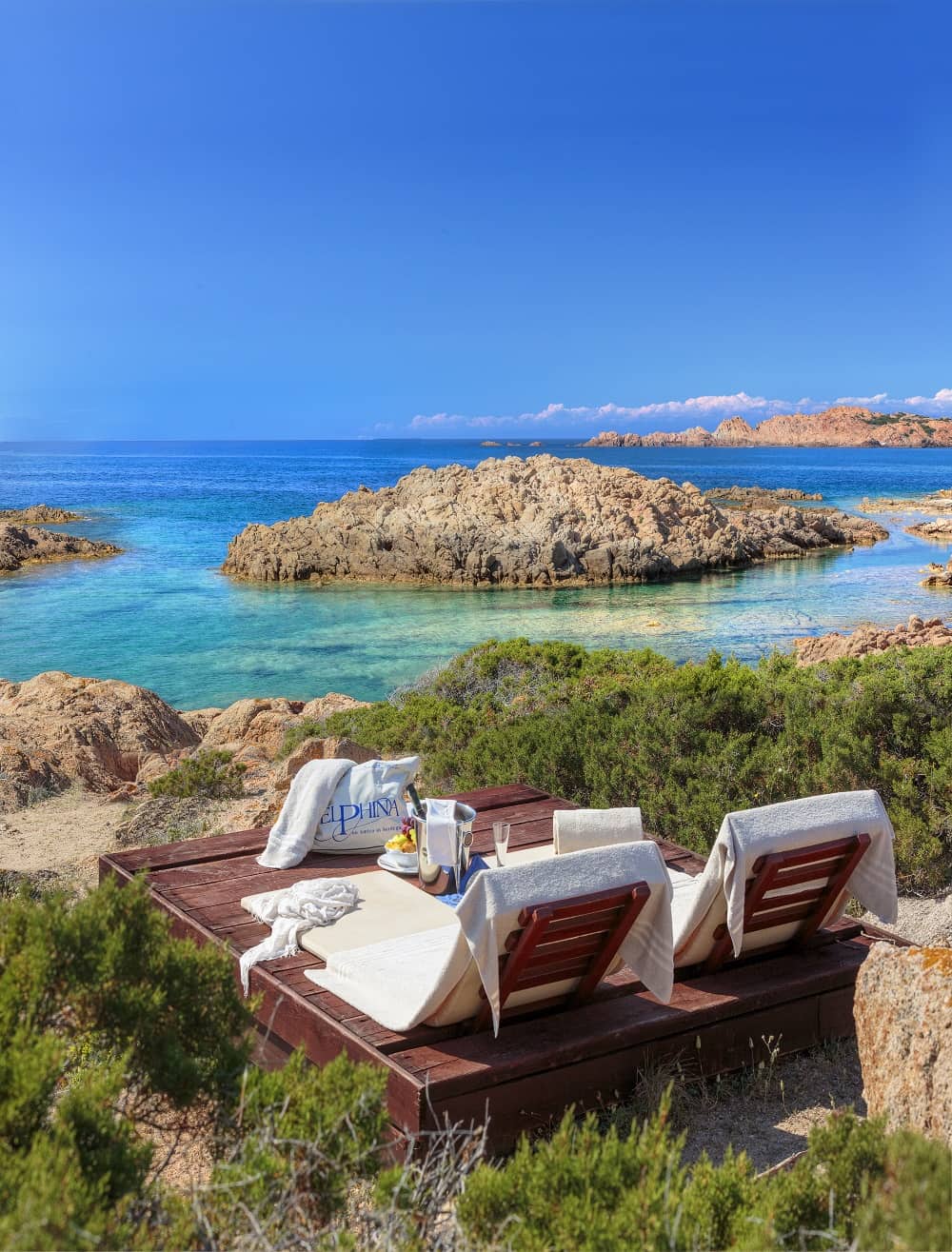
Delphina launches an ecotourism project to communicate the beach holiday in North Sardinia with an eco soul.
Delphina's 25-year history tells the story of an exceptional landscape: a collection of 4- and 5-star hotels overlooking the sea in North Sardinia, in Gallura, between the Costa Smeralda, the La Maddalena Archipelago and the Gulf of Asinara. The hotel chain has always paid great attention to the environment and ecotourism.
So Delphina has created an authentic brand: "We are green", created and registered by Delphina to represent its commitment to the environment. It is a collection of good practices and initiatives to enhance the territory, tracing a path for a sustainable future of the Sardinian land.
About the author
Written on 29/06/2021

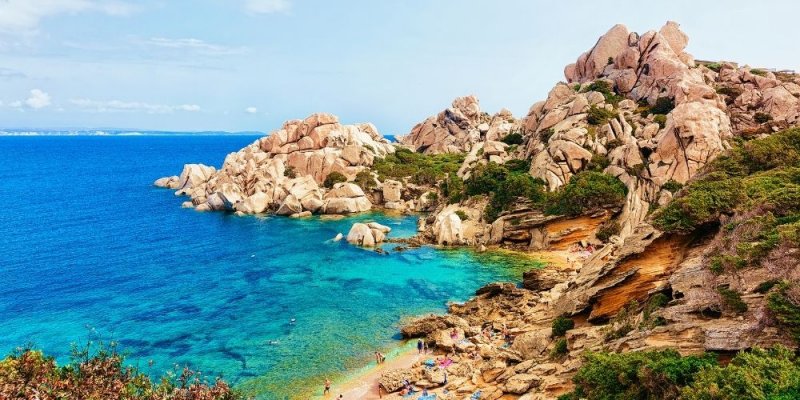

Alessandra Festa
Gallura, the north-eastern part of Sardinia, is famous for its heavenly sea and breathtaking views. But that's not all: the region offers many opportunities among history, folklore, culture, and millenary traditions.